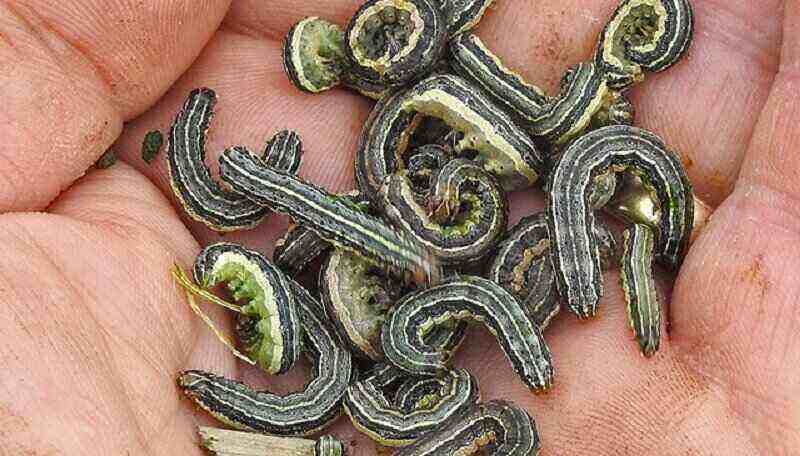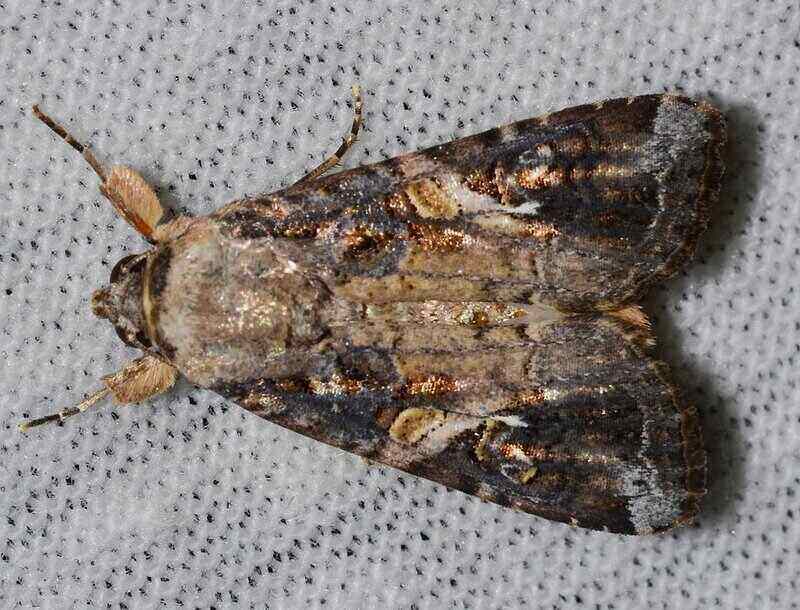How to Get Rid of Armyworms
BY BRENDA STUART | AUGUST 16TH, 2022 | BLOGArmyworms can turn your lawn into their own private mess hall in no time. They travel in platoons like soldiers and can devour a golf course, playing field, or your yard in just two or three days. We will show you how to get rid of armyworms before they destroy your lawn.
In this article, we’ll explore:
- How to Identify Armyworms
- How to Get Rid of Armyworms Naturally
- Insecticides That Kill Armyworms
- How to Prevent Armyworms
- How to Determine if Armyworms are the Problem
- FAQ About Armyworms
How to Identify Armyworms
It’s not the adult armyworms you need to worry about, but the infantry. Yes, the worm in its infant or larva stage devours grass and leaves to grow to adulthood. You can win the battle against this army if you know how to identify the youngest members.
Armyworm Larva

The larvae range from dark green and brown to black. They’re only about an inch and a half long, so it might be tough to see the white, orange, and dark brown stripes along the caterpillar’s sides. However, its red or yellowish-capped head is a dead giveaway.
Armyworm Moths

Although the armyworm caterpillar is the grass-eating culprit, it’s the adult moths who lay the eggs – thousands of them at a time. Get rid of moths, and you get rid of the armyworms.
You can identify armyworm moths by their inch-and-a-half wingspans. Their underwings are white, and their upper wings are light tan to brown with white specks.
Moths are attracted to lights and will lay their white, round eggs on the underside of leaves, grass blades, and structures near turf.
How to Get Rid of Armyworms Naturally
The good news is armyworms cannot tolerate temperatures below 50 degrees. The bad news? Many species will fly to Florida or South Texas for the winter. There are several ways to get rid of armyworms without using chemicals.
1. Mow Your Lawn Often
In addition to running over the caterpillars, the shorter turf leaves survivors to die from exposure to the sun. Even if you plan to use insecticides, a shorter lawn will enable the chemicals to penetrate the soil.
2. Attract Armyworm Predators to Your Yard
Birds, ants, spiders, flies, ground beetles, and other beneficial insects feed on armyworms. Don’t be so quick to shoo away the wasps. Their next meal could save your lawn.
3. Add Beneficial Nematodes to Your Soil
These microscopic organisms feed on armyworm larvae, grubs, and hundreds of other garden pests. Nematodes won’t harm you, your plants, or the pollinators your plants depend on. Make sure you read the package directions and buy a species that targets armyworms.
4. Plant Armyworm-Repelling Plants
Aloe and marigolds produce a scent that armyworms find unappealing. Farmers will often plant tick clover or desmodium in their corn fields to keep the armyworms away.
5. Neem Oil
A light spray of neem oil on your plants and lawn will kill the armyworm caterpillars within three days. This biological solution is perfectly safe for wasps, flies, and other armyworm predators.
6. Bacillus thuringiensis
Bacillus thuringiensis (Bt) is a naturally occurring soil bacterium that’s toxic to armyworm larvae. Bt occurs naturally in soil, so it has no adverse effects on the environment. You can buy Bt in dust form, pellets, or sprays and apply it to your lawn.
Insecticides That Kill Armyworms
If the armyworm population in your yard is out of control, you may have no choice but to resort to an insecticide. Ortho and Spectracide offer several insect-killing lawn products that you can apply directly to your grass.
Before buying an insecticide, make sure it contains one of these ingredients to get rid of armyworms:
1. Bifenthrin
This highly toxic chemical will kill armyworms, but it’s also toxic to people, pets, bees, and fish. Be careful that you don’t use so much that it runs off into nearby waterways.
2. Deltamethrin
This pyrethroid comes in granular form. It kills armyworms and other grass-munching bugs by disrupting the nervous system. It won’t kill earthworms or birds, but it is toxic to fish and bees.
3. Permethrin
Another man-made insecticide, permethrin comes in granular and spray forms. Use with extreme caution as permethrin is also poisonous to people.
4. Spinosad
This soil bacteria controls a wide variety of lawn pests and usually works within two days. The chemicals break down quickly in the soil and don’t contaminate groundwater. Most products containing spinosad are approved for organic agriculture.
When and How to Apply Pesticides for Armyworms
Since armyworm caterpillars are most active at night, it’s best to treat your lawn at sundown. Use a heavier dose if the grass is thick or the armyworm population is extremely high.
Before applying an insecticide, water the area well. The moisture will bring the armyworm larvae to the surface.
How to Prevent Armyworms
The fall armyworm is one of the worst backyard pests in the U.S., destroying lawns and gardens faster than any other insect or lawn disease. You can reduce your risk of an armyworm invasion with a few preventative measures.
1. Keep Your Yard Weed Free
Remove the weeds, especially the broadleaf weeds like common chickweed and dandelions, where armyworm moths often lay their eggs.
2. Dethatch
The debris and grass clippings that build up between your grass and the soil are another great host where the adult armyworm moths can lay eggs. Dethatch your lawn every spring, so the armyworms have no place to hide.
3. Keep the Ground Moist
Armyworms look for hot, dry places to lay eggs and feed. Give your lawn at least an inch of water a week to make your yard less inviting.
4. Preventive Pesticides
Don’t wait for an infestation. Apply a preventive pesticide containing either methoxyfenozide, diflubenzuron, or chlorantraniliprole at the end of the spring and again in the fall. Follow all package instructions and use a slow-release insecticide that will last through the summer.
5. Plant Armyworm-Resistant Grass Types
Bunch grasses like ryegrass, St. Augustine, Bermudagrass, and fescue take the biggest hit from armyworms. Grasses with rhizome and stolon growth like Bermudagrass typically recover better.
You’re better off planting Zoysiagrass. For some reason, armyworms don’t like the taste of the fine blades. The larva also tend to shy away from grass mixes, so next time you’re overseeding, add a different variety of seed to your lawn.
How to Determine an Armyworm Infestation
Identifying the armyworm enemy is crucial. To determine a count of the armyworms in your yard, begin with a soap flush. Use 2 tablespoons of liquid dish soap mixed with 1 gallon of water. Pour the mixture over a small area. Armyworm larvae and other insects will come to the surface.
If you find only a handful, you can hand-pick them off your plants and drop them into another bucket of soapy water. Entomologists recommend a more extensive treatment when there are more than three caterpillars per square foot.
FAQ About Armyworms
1. Are armyworms harmful to people or pets?
No. Armyworms will not bite or sting. They are not poisonous if consumed and do not transmit diseases. They are harmful to plants and cause major economic concerns for farmers.
2. What are the signs of an armyworm infestation?
A lawn with an armyworm infestation will give off a frosted appearance or resemble drought stress at first. The tips of the grass blades where the armyworms are feeding will appear translucent. You will also notice a number of birds visiting to feast on the pests.
3. Are there certain plants and grass types the armyworms prefer?
Yes, the adult moths will look for plants with larger leaves to host their eggs. The armyworm larvae prefer:
- Bermudagrass
- Ryegrass
- Fescue
- Bluegrass
Sometimes, they’ll attack a bentgrass lawn, too. Of these grass types, Bermudagrass has the best chance of recovering since it spreads by fast-growing rhizomes and stolons.
4. Do armyworms stick to states with warmer climates?
No. Although armyworms prefer warm, dry weather, you’ll find them in every U.S. state except Alaska.
Feel like you’re fighting a losing battle against armyworms and other lawn-destroying insects? We can help you find a lawn care professional near you to take care of all your lawn pest problems and give you tips to prevent future infestations.
Main photo credit: USGS Bee | Flickr